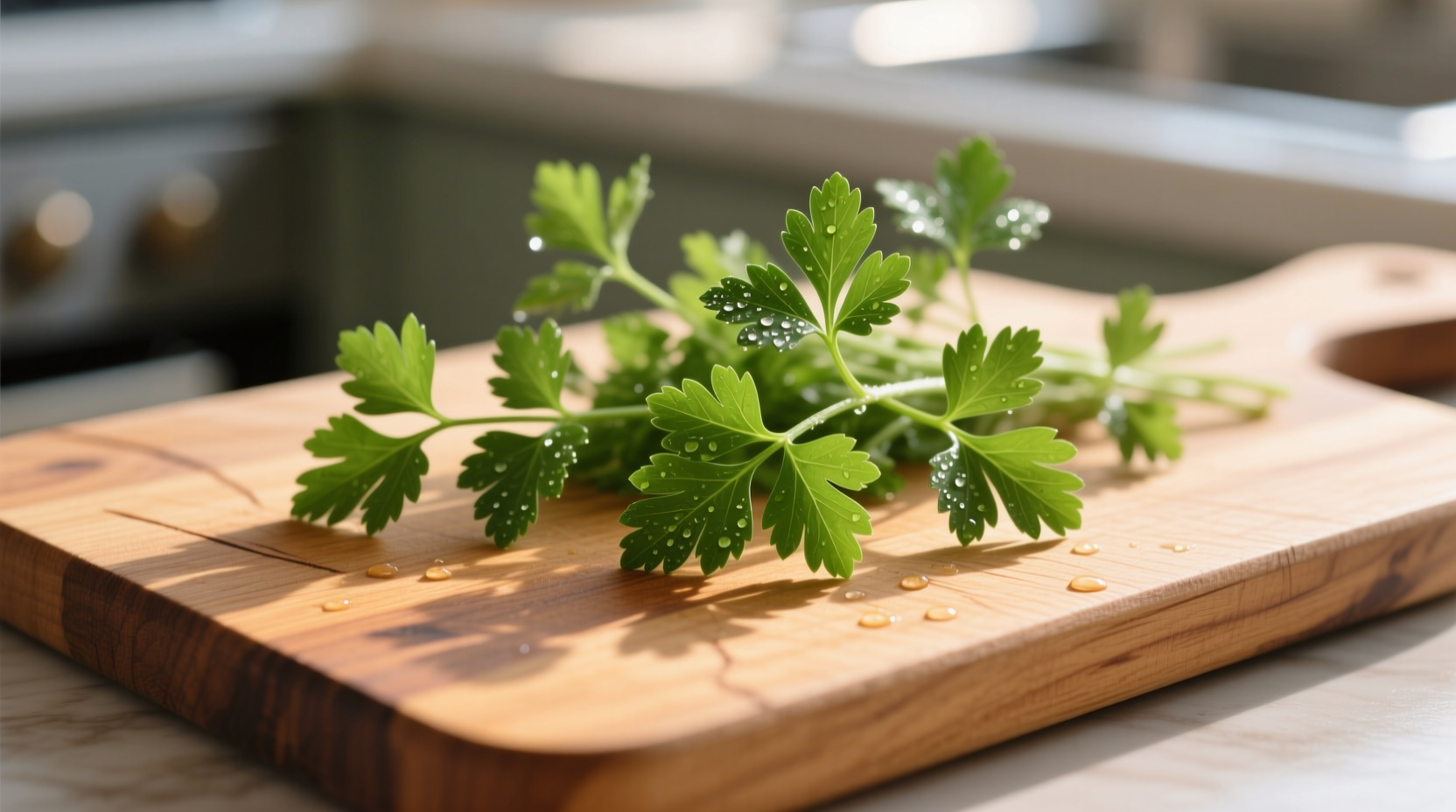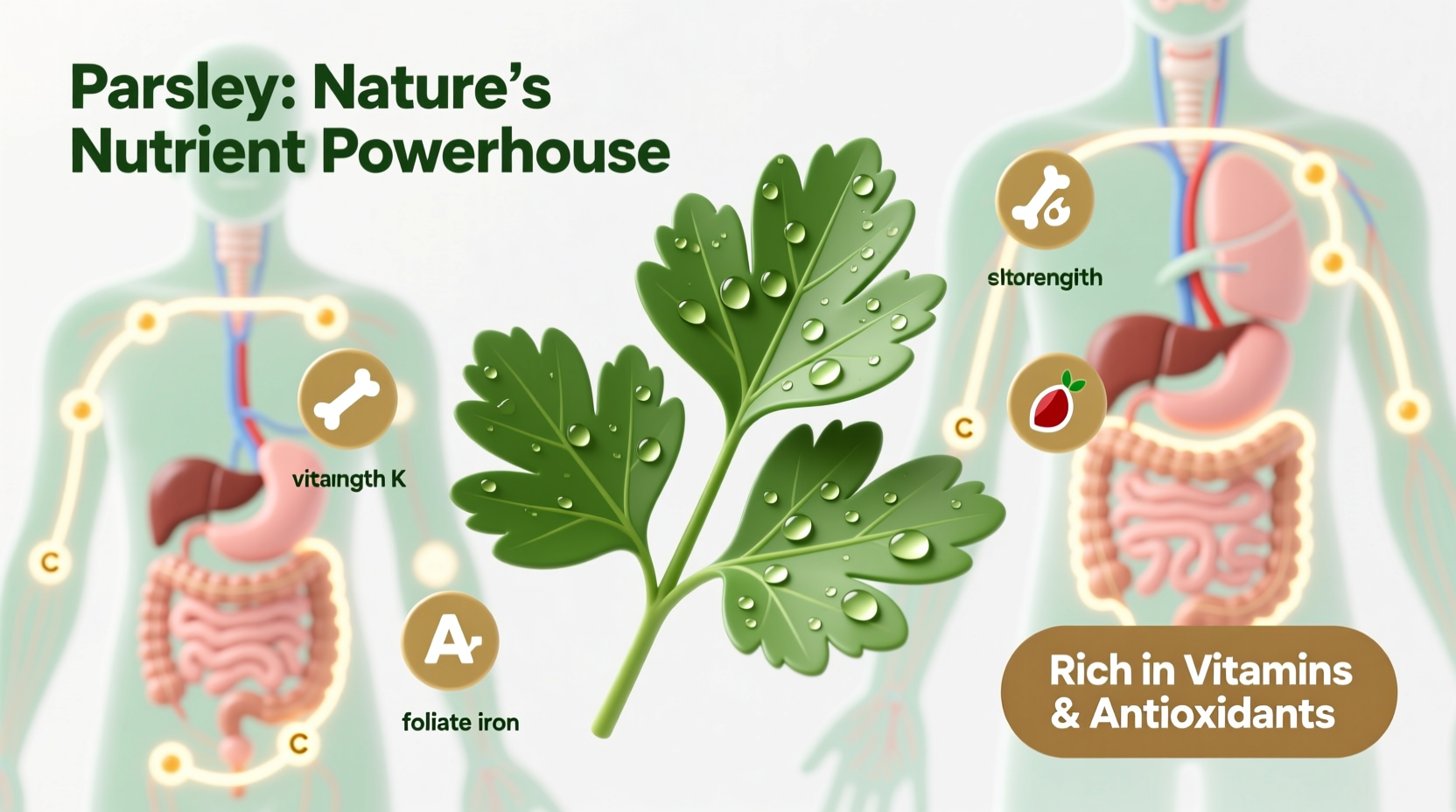Discover why this humble kitchen staple deserves a starring role in your diet—not just as a garnish but as a nutritional powerhouse backed by science. In the next few minutes, you'll learn exactly how parsley benefits your body, the optimal ways to incorporate it into meals, and who should exercise caution.
The Nutritional Powerhouse You're Underestimating
Most people toss parsley aside as mere decoration, but this herb packs a serious nutritional punch. According to USDA FoodData Central, a single cup (60g) of fresh parsley contains:
| Nutrient | Amount per Cup | Daily Value % |
|---|---|---|
| Vitamin K | 1,230 mcg | 1,025% |
| Vitamin C | 133 mg | 148% |
| Vitamin A | 8,424 IU | 168% |
| Folate | 108 mcg | 27% |
| Iron | 4.0 mg | 22% |
These numbers reveal why nutritionists consider parsley one of the most nutrient-dense herbs available. Its vitamin K content surpasses even kale, while its vitamin C concentration exceeds that of oranges by weight.

Science-Backed Health Benefits You Should Know
Bone Health Champion
Vitamin K plays a crucial role in bone metabolism by activating osteocalcin, the protein that binds calcium to bones. Research published in the American Journal of Clinical Nutrition found that higher vitamin K intake correlates with reduced fracture risk. Just one tablespoon of parsley provides 21% of your daily vitamin K needs—making it an easy addition to support skeletal strength.
Immune System Support
The vitamin C in parsley stimulates white blood cell production and acts as a powerful antioxidant. According to the National Institutes of Health, adequate vitamin C intake can reduce the duration of common colds by 8% in adults. Unlike supplements, parsley delivers vitamin C alongside flavonoids that enhance its absorption and effectiveness.
Natural Anti-Inflammatory Properties
Parsley contains apigenin, a flavonoid with demonstrated anti-inflammatory effects. A 2020 study in Nutrients showed that apigenin inhibits inflammatory pathways associated with chronic diseases. The herb's volatile oils, including myristicin, also contribute to its inflammation-reducing potential.
Practical Ways to Maximize Parsley's Benefits
Optimal Consumption Guidelines
For most adults, consuming 10-15 sprigs (about 1/4 cup chopped) daily provides significant benefits without risk. To maximize nutrient absorption:
- Pair with healthy fats: Vitamin K is fat-soluble—add parsley to olive oil-based dressings
- Avoid prolonged cooking: Heat degrades vitamin C—add parsley at the end of cooking
- Store properly: Keep stems in water like flowers, covered with a plastic bag in the refrigerator
Simple Incorporation Strategies
You don't need complicated recipes to enjoy parsley's benefits:
- Replace half your basil with parsley in pesto for added nutrients
- Blend into morning smoothies (the chlorophyll masks the flavor)
- Create a "green sauce" with parsley, capers, and lemon for proteins
- Add to grain salads instead of lettuce for more staying power
Who Should Moderate Parsley Intake
While parsley benefits most people, certain individuals should exercise caution:
- Blood thinner users: Vitamin K counteracts medications like warfarin. Maintain consistent intake rather than sporadic large amounts. Consult your physician about appropriate consumption levels.
- Kidney stone sufferers: Parsley contains oxalates, which may contribute to calcium oxalate stones. Those with a history should moderate intake.
- Pregnant women: While culinary amounts are safe, medicinal quantities may stimulate uterine contractions according to research from the National Center for Biotechnology Information.
Parsley Through History: From Ancient Remedy to Modern Superfood
Parsley's journey from ancient medicinal plant to kitchen staple reveals why modern science confirms its value:
- Ancient Greece: Used as a victory wreath and to treat digestive issues
- Roman Empire: Employed as a diuretic and breath freshener
- Medieval Europe: Recognized for wound healing properties
- Modern Research: Validating traditional uses with scientific evidence on antioxidant and anti-inflammatory effects
This historical context shows how contemporary nutritional science often confirms traditional wisdom—when it comes to parsley, our ancestors were onto something valuable.
Parsley vs. Other Common Herbs: Where It Stands Out
While all fresh herbs offer benefits, parsley excels in specific nutritional areas:
| Nutrient | Parsley | Cilantro | Basil | Mint |
|---|---|---|---|---|
| Vitamin K (mcg/cup) | 1,230 | 310 | 89 | 220 |
| Vitamin C (mg/cup) | 133 | 27 | 18 | 13 |
| Antioxidant Capacity | ★★★★★ | ★★★☆☆ | ★★★☆☆ | ★★☆☆☆ |
Source: USDA FoodData Central (2023)
Putting Parsley to Work in Your Kitchen
Transform your meals with these chef-approved techniques:
- The Double-Chop Method: Finely chop parsley twice to release maximum nutrients and flavor
- Citrus Activation: Toss chopped parsley with lemon juice to preserve vitamin C
- Freeze for Longevity: Blend with olive oil and freeze in ice cube trays for ready-to-use portions
- Root-to-Stem Usage: Don't discard stems—they contain higher concentrations of certain nutrients than leaves
Frequently Asked Questions
How much parsley should I eat daily for health benefits?
For most adults, 10-15 sprigs (about 1/4 cup chopped) daily provides significant nutritional benefits without risk. This amount delivers approximately 21% of your daily vitamin K needs and 15% of vitamin C. Consistency matters more than large occasional servings, especially for those on blood thinners.
Can parsley help with inflammation?
Yes, research shows parsley contains apigenin and other flavonoids that reduce inflammation. A 2020 study in Nutrients demonstrated that apigenin inhibits inflammatory pathways associated with chronic diseases. Regular consumption of fresh parsley as part of a balanced diet may help manage inflammation, though it's not a replacement for medical treatment.
Is there a difference between flat-leaf and curly parsley nutritionally?
Flat-leaf (Italian) parsley generally contains slightly higher concentrations of nutrients than curly parsley. According to USDA data, flat-leaf varieties have about 15% more vitamin C and 10% more vitamin K. Flat-leaf also has a stronger flavor profile and is easier to chop, making it preferable for most culinary applications where nutritional density matters.
Can I eat too much parsley?
While culinary amounts are safe for most people, excessive consumption (multiple cups daily) could cause issues. The high vitamin K content may interfere with blood thinners, and large amounts might irritate kidneys due to oxalates. Pregnant women should avoid medicinal quantities as compounds in parsley may stimulate uterine contractions. Stick to moderate culinary use—about 1/4 cup chopped daily—for optimal benefits without risk.











 浙公网安备
33010002000092号
浙公网安备
33010002000092号 浙B2-20120091-4
浙B2-20120091-4